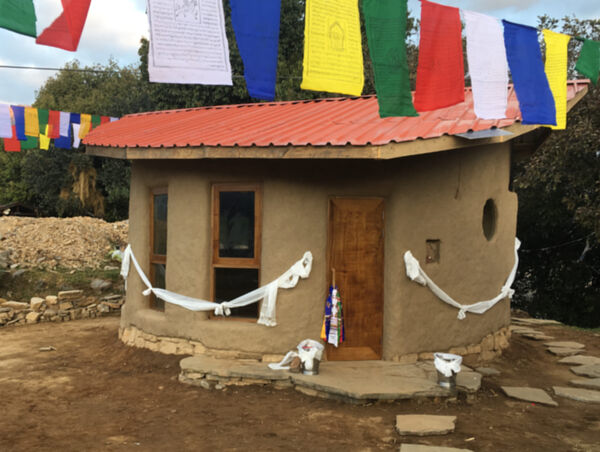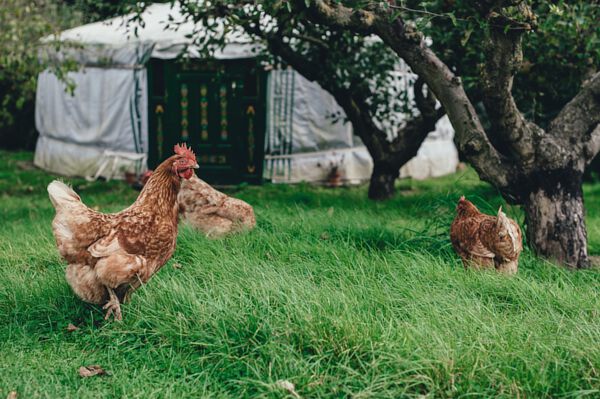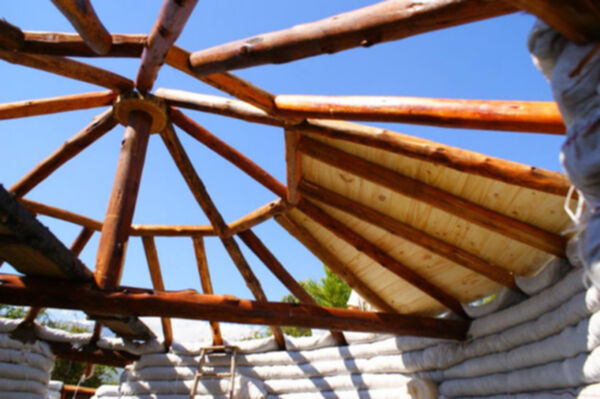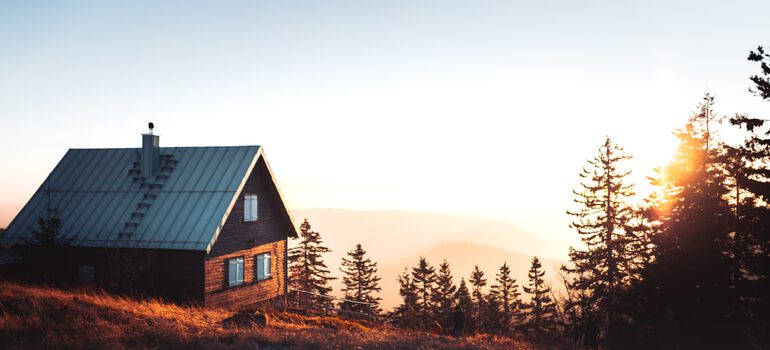So many aspiring homesteaders are stuck on the high price of buying a house. But for those willing to do it themselves, there are some many better options out there that you may never have heard of. Here ar 10 good ways to build off grid for less money.
How do you building an off grid cabin? Here are 10 ideas —
- Log cabin
- Cob structure
- Timber frame
- Straw bale
- ICF (Insulating concrete forms)
- Yurt
- Standard stick framing
- RV or Trailer
- Underground “hobbit home”
- Earth bag
Besides being cheaper to build, all of these methods of strengths in certain areas that make them much more desirable than a commercially built home for living sustainable off the grid. Below I’ll discuss the strengths and weaknesses of each method, as well as ways you can get started constructing your off grid home today.
Off Grid Log Cabin Building
The hallmark of homesteading and the frontier lifestyle, log cabins offer many benefits for those choosing to live off the grid. Choosen by our ancestors because they are comfortable, durable, and fast to build, if you have trees on your property, then a modern log cabin build is something to consider.
The biggest benefit of building a log cabin is the low cost and relatively low amount of work it takes to build a log cabin structure. Unlike more difficult forms of modern carpentry, log cabin building is something that anyone can learn, and can even be accomplished realatively quickly with hand tools.
Myth — Log Cabins Aren’t Insulated
Typicall 6" framed exterior walls in the United States are about R-20 when insulated. While wood has a lower insulation value per inch (about 1.5 R/inch), log cabin walls are as thick as the tree you have available, and are usually much thicker than 6" walls. At only 13" thick on average a log cabin wall is just as insulated as a stick frame wall. At 20" thick you have R30.
Well built log homes have the potential to be just as insulated or more insulated than typical modern homes. Also, you have the option of installing rigid foam insulation, or extra attic insulation to beef up your thermal efficiency even more.
Myth — Log Cabins Waste Wood
While it may seem at first glance that log cabins use a lot of extra wood compared to a wood framed house, that just isn’t the case. The process of producing commercial lumber involves sawing and trimming that produces a large amount of saw dust and off cut wood.
Calculations in the Revised Log Cabin Construction Manual estimate that an average log cabin uses about as much wood as the same size stick frame home. Yet, by sourcing your logs locally or off your own land, you save on the cost and environmental pollution associated with trucking lumber from forest, to lumber mill, to lumber yard, then to your building site. This makes log cabins cheaper and more environmentally sound in most cases when compared to stick frame construction.
How to Build a Log Cabin
I have read several books on log cabin building, and the best option I have found by far for the practical builder is the Revised Log Cabin Construction Manual. Filled with color photos and practical wisdom, this is my recommendation someone who is serious about building an off grid log cabin.

Sustainable Cob Building
One traditional material that most people haven’t heard of, is versatile and easy to work with Cob. Cob is a traditional name for Earth based building techniques that yields rock solid thick walls for very low cost.o
What is Cob? Cob is a mixture of soil, clay, and plant fiber (aka natural rebar) that is kneaded to a thick dough like consistency, then hand molded to form appealing free-form walls.
The biggest benefit of Cob is that all the materials can be had either locally or very near the build site, if not directly from it. Dirt, clay, and straw are found in every area of the country, and are cheap.
Cob building is very easy to learn, and accessible even to people who may not be physically able to lift or build using other methods.
Does Cob Have Moisture Problems?
The first concern that people have when they learn about cob building is that cob would be susceptible to moisture, like a wet basement. The short answer is that, no, cob does not have particular moisture problems. In fact, cob handles moisture much better than most modern homes.
Cob is a partially water permeable material, so it lets moisture in or out of the home, but it is also a moisture buffer. This means that the thick and massive walls will work to even out the moisture level in the room, removing the need for active humidification or de-humidification.
Homes built with cob work great in both moist and dry climates. Here in rainy Oregon, there are many examples of modern cob homes that are quite comfortable in the wet environment. In fact, cob works so great that showers in cob homes don’t even fog the mirror, because the moisture is absorbed by the cob walls in the bathroom, and over time discharged outside.
How Long Will Cob Last?
Examples of cob style homes exist all over the world, many of them hundreds of years old. Cob walls will not rot or go bad over time. So long as they are protected from direct rain by a proper stem wall
If you live in an area with driving rain that strikes the earth walls directly, then you may have to maintain the cob walls occasionally. Exterior walls with an earth plaster finish may need occasional refinishing, which amounts to a few hours of fix up work about once a year in most cases. Or, you have the option of finishing your exterior with limestone plaster, which leaves it protected damage due to driving rain. NOTE: Materials impervious to water such as concrete plaster should not be used on cob walls, since they tend to trap water in the wall, which unfortunately has lead to serious damage to historic cob structures in the past.
Saving on Heating and Cooling with Cob
One of the best qualities of cob is that it is a massive thermal battery, much like the walls of a cave. While the overall insulation value of cob is not particularly high, thick walls and smart passive solar design allows cob structures to be both warm in the winter and cool in the summer.
I have personally experienced the cooling benefits of cob in the hot late summers of northern India, where several cob tiny homes were the preferred afternoon hang, staying much more comfortable without any air conditioning at all than any of the other concrete or wood buildings.
More ways to save money with smart off grid air conditioning:
How to Build Cob
The go to book for cob builders is the The Hand-Sculpted House, however there have been some improvements to the methods presented in this book over the years. Probably the best way to learn to work with cob is though a weekend or longer cob building course. Cob courses are held regularly all over the world.
DIY Timber Frame Cabin
One increasingly popular method of building off grid is timber frame construction. To me, timber framing is somewhere between standard stick-frame construction and log cabin construction.
Timber framing uses large timber beams to form the skeleton of the home, constructed without nails using traditional wood joining techniques. Historically, timber framing has been a part of many cultures spanning across the centuries. In Japan, there are timber framed pagodas which have stood for well over 1300 years.
Benefits of Timber Framing
Like log cabin building, you have the possibility of harvesting local timber or trees you already have on your property for timber frame building. However, building with timber frame required a bit more prep-work than log cabins, since you would need to mill the logs in to beams.
On big potential upgrade that timber frames provide is increased flexibility in design of your home. Timber frame designs can be built that look the same as a “normal” house, or you can build to emphasize the rustic elements of timber frame construction.
Another benefit of timber framed homes is that there is an accepted engineering practice around timber construction. Which means you have the option of building to plans approved by an engineer, and building entirely within code, even in areas with strict building departments. Likewise, you may be more easily able to sell a timber framed home in the future, as compared to more exotic techniques on this list, since buyers will be able to get a mortgage on the structure.
Lastly, timber framed homes can be built quite quickly once you have the materials on hand. With joints prepped and plenty of help, a timber structure can be raised often in a single day, which makes for a fun get-together for friends and family to help in the raising, and later in the feasting.
How to Build a Timber Frame Cabin
Timber farming is something that I have less hands on experience with than other methods on the list, although I have watched quite a few videos on the subject, and feel justified in saying that you should take the time to learn the fundamentals before embarking on a large project. If you are already a woodworker, then you may be able to get started building timber frames right away. For the rest of us, a course on the subject would be an excellent start.

Quick and Easy Straw Bale Home
Straw bale is another earth based method, like cob, that boasts an accessible and earth friendly methodology with some benefits and trade offs compared to cob.
Unlike cob, where the structural integrity of the wall comes directly from the earth mixture, straw bale construction stacks up square bales of straw to form core of the wall. On top of and in to the straw, a thick layer of earth plaster is spread, permanently sealing and protecting the straw from the elements.
The benefits of this method are twofold — faster construction times and higher insulation value.
In very cold climates that get little sun, the benefits of cob’s thermal heat storage doesn’t outweigh the reduced insulation value of earth. Straw bale fixes this problem, by leaving much more dead air space in the wall, significantly increasing the R value.
Straw Bale and Building Codes
Unlike may other natural building techniques, straw bale has recently found it’s way in to national building codes, particularly the International Residential Code (IRC) Appendix on Straw Bale. The IRC is an international building code primarily originating from the United States, with almost every state implement some or all of the code in their local building laws. Because of the adoption of straw bale building in the code, it makes it much easier for people interested in getting a building permit for their straw bale structure.
The straw bale code specifies a building method a bit different than what you might find natural builders teach. The biggest difference is that code compliant straw bale requires a small amount of stick framing to support the roof and upper floors if any.
ICF Cabin Construction
A modern approach to cabin building which I have seen adopted by several prominent off grid personalities is the use of insulated concrete form (ICF) construction. If you are wanting the durability and protection of a concrete structure, hoping for a DIY accessible solution, and require good insulation in your area, then ICF might be the right choice for you.
ICF structures are essentially concrete buildings, built with an insulating layer of foam on both the inside and outside of the structure. ICF walls are build using purchased ICF foam “blocks”, which fold open and snap together to make the shell of a completed wall. Unlike normal concrete construction, which requires complex custom built wooden or metal forms to poor the concrete, ICF blocks are the form. Although, they do need some temporary exterior support boards to keep them together while pouring the concrete.

Low Cost Off Grid Yurt
Probably the lowest cost options for living off grid, yurts are a great option for those looking to live debt-free, or who live to travel.
A yurt is a large, semi-permanent round tent like structure that originates from the steppes of Asia. Designed to survive very cold winters, yurts are extremely light and durable for their size. While historically made of wood or bone with an animal felt skin, modern yurts tent to have a wooden lattice with vinyl or canvas sides.
Small yurts can be bought online for as little as a few thousand dollar, while larger yurts tend to cost anywhere between $10,000 – $20,000 for base models. Yurts are also something that you can readily make yourself if you have modest skills with wood working and sewing.
While yurts are fairly expensive, they require quite a bit of heat to maintain a comfortable level in a cold environment. Traditional yurts had open fires in the center, with hole at the peak to allow smoke to exit. Modern yurts to well with wood stoves or ever rocket mass heaters.
Building a Standard Stick Frame House
If the thought of living in a yurt or a cob house doesn’t meet your fancy, then perhaps sticking with what you know is best. For many offgridders, a standard stick frame home would do just nicely.
One option for the industrious homesteader is to build their own stick frame home. Homes you build yourself can be much less expensive, especially if you are willing and able to take the time to accumulate scrap material from building sites in you are. Check out my article on “Living Off Grid With No Money” for more details on how you can find free or low cost building materials.
Another thing to consider along this vein is the construction of a tiny home, either on wheels or on a foundation. For the outdoor minded individual, the home is only a small part of your living space. And significantly downsizing the overall dimensions does a lot to make homestead living approachable on modest budgets. Remember, if people in Tokyo, New York, and London can live in only 100 sqft, then a hearty country individual, couple, or a family with space to roam should be able to get by with less than 1000.
How to Build Your Own House
While there are very many skills required when building your own traditional home, ranging from concrete, framing, plumbing, and electric, if you are willing to learn and have the ability to work hard, you will eventually reach the goal.
If you haven’t seen it already, YouTube is a great resource for demonstrations of practical skills on a wide range of topics, but it is helpful to have a single resource that lays everything out. The best book I have found in this regard, hands down is How to Build a House. I learned framing from the author Larry Haun’s earlier works, and he has a wonderful way of making construction tasks seem easy and understandable. This book has been teaching thousands of people how to build homes as part of Habitat for Humanity, and is probably the best all in one resource for the DIY home builder.
RV and Trailer Offgridding
By far the quickest way to get started living off grid, RV’s, campers, and trailers find their way in to the living plans of the majority of aspiring homesteaders. Whether as a temporary home base while building the real cabin, or as a more permanent place to hang your hat, RV’s shouldn’t be discounted entirely.
RVs typically come with heat, refrigeration, and other appliances. With a well, off grid power, and proper hookups installed an RV can quickly become a comfortable yet portable place to stay.
Perhaps the greatest benefit, is that if you just want to try out the off grid lifestyle, with an RV you always have the option of just driving back in to the city, rather than having a permanent cabin to worry about selling. RVs can be used to leverage access to free use land as available, especially in Canada where crown land can be lived on without rent, but only for a few months at a time.
Digging and Underground Home
If living in a hobbit hole intrigues you then you might consider making one of your own, like this underground dome house. While underground homes require a tremendous amount of digging, they are nearly impervious to the cold and the heat. And, can be blended in seamlessly with the natural surroundings keep your abode nearly invisible to the casual observer.
Over the years I have found several off grid or minimalist individuals who have built their home underground. Their construction efforts range widely, everything from plush underground mini-caves, to the full size underground dome home linked to above.
Building underground is still an area open for discovery, so aspiring subterranean builders will need to be creative and inventive regarding their construction techniques and engineering methods.

Eco-Friendly Earth Bag Construction
The last option on this list is earth bag construction. Another building method that relies on earth as the primary material, earth bag constructions have similar benefits when complete to cob, straw bale, and other earth based methods.
Compared to the other methods, the primary benefit of earth bag construction is the speed with which your can progress. Unlike cob, where each layer of earth needs time to dry, earth bag doesn’t require down time.
There is a large community of earth bath enthusiasts, especially centered around the Earthship community in New Mexico. Earthship designs have been develop since the 1970’s utilizing a wide variety of methods, and having a particular focus on reusing recycled materials.
Earth bag homes have been constructed all over the world, with the oldest examples standing for nearly 50 years.
Related Questions
How much does it cost to build a off grid cabin?
The cost depends on your skills and access to materials. Thrifty DIYers have been able to build cabins for less than $1,000. Meanwhile, typical commercial rates for a moderately sized cabin would amount to $75,000 – $100,000.
How do you make an off grid cabin?
There are many cheap and accessible ways to build an off grid cabin, including — log cabins, cob cabins, timber frame cabins, straw bale cabins, ICF cabins, yurts, standard stick frame cabins, mobile homes, underground cabin, and earth bag cabins.


